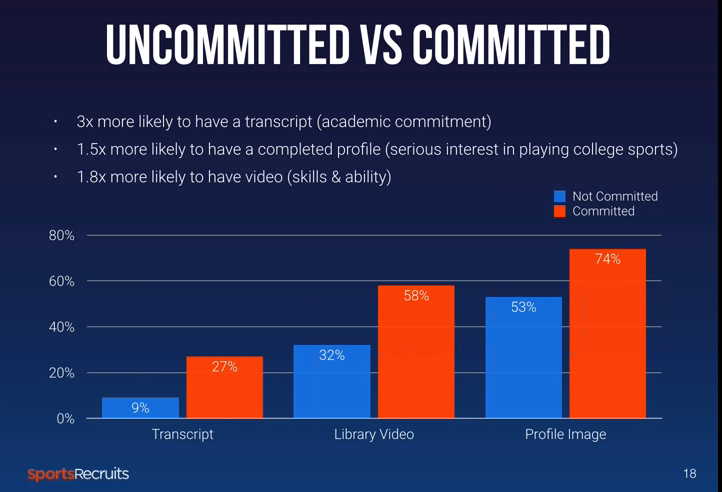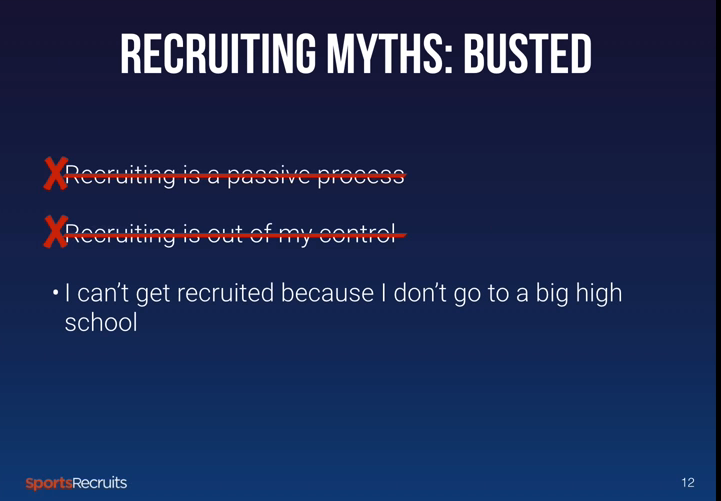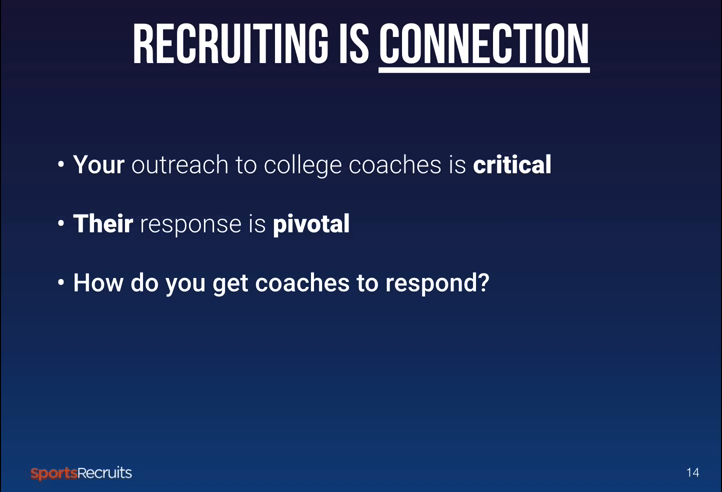In “Details,” Part 2 of our 4-part Webinar Series “Engineering the Perfect Recruiting Process,” Sports Recruits Co-Founder Matt Wheeler discussed how some of the small details that are often overlooked in a student-athlete’s recruitment can make a huge difference.
In the Webinar, Matt touches upon how the recruiting effort is not a reactive process based on luck – but rather a proactive one that is controllable.
You can watch the video below, and also read some of the interesting takeaways from the presentation below.
Takeaway One: Do the Simple Things
What It Means: Once you have your target list of schools, the process really comes down to giving coaches what they want: grades, video and the intangibles that exemplify your concern for the process.
Here is some interesting data from the users of our platform that have committed to play their sport at the next level. These users were:
• 3x more likely to have a transcript (Providing Academic Data)
• 1.8X to have video (Showcasing athletic ability)
• 1.5X more likely to have a complete profile (Exemplifying attention to detail)
You can create a strong first impression by showing your commitment to the process.
Said another way: The little things add up over time.
From the presentation: “We are trying to ensure that everyone understands that you have this process in your grasp. Attention to detail is very important, and is something coaches notice – so do sweat the details.”
Takeaway Two: Beware of the Recruiting Myths
What It Means: Per the NCAA Participation Report, there are over 7 million high school sports competing for 409,207 spots on NCAA rosters. As such, this can often lead to the belief that the recruiting process is a matter of luck or happenstance.
These thoughts can be fueled by parents talking on the sidelines, rumors in town, Internet chatter and other avenues where genuine, honest confusion about the process can feign clarity.
Suddenly credence is given to myths suggesting that recruiting is out of your control, that you aren’t good enough or that you aren’t getting recruited because you don’t go to a notable high school in a hotbed area for your sport.
However, this is all looking at the process re-actively as opposed to proactively. If, conversely, you take the right steps to put yourself in control, you will feel much better about the process.
What are these steps? First, create a target list of schools that are a good fit academically. Next, get realistic feedback on your athletic abilities and the schools that you should be focused that match your academic profile. Finally, contact those coaches and take your game to them.
If you do the steps in order, the recruiting myths and outside noise will not be of note to you.
From the presentation: “People will ask us ‘how do I get recruited.’ By saying that makes it a passive thing. That demonstrates a flaw in how people think about this process – that it is something that happens to you. While that may be true for a very small amount of student-athletes, for the other 99.9%, you are the central character of the process. It doesn’t happen to you. You make it happen.”
Takeaway Three: Make Connections
What It Means: Life is a contact sport. So too is the recruiting process.
Once you have a solid list of schools you are interested in and that are a good fit, the only way to ensure you are on the radar of the coaching staff is by brining your game to them.
The way to do that is to provide them with everything they need to recruit you: Academic information, highlight reels and reasons you are interested in the program are a good start.
Try to get a response – good or bad. This does not mean be a pest, but you need to demonstrate lots of interest in their specific program.
From the presentation: “You can empty the bank account and attend every event possible. But if you don’t do the proper outreach, provide video, provide grades and the resources coaches need to recruit you, the process won’t start moving. Outreach is really important.”





